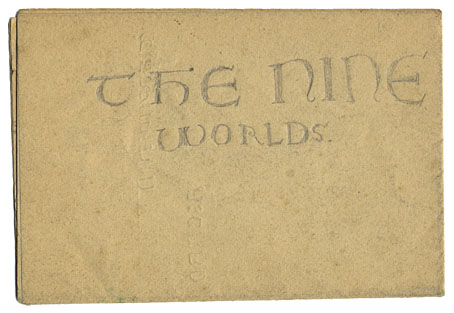
Following the mention yesterday of my facsimile John Speed map I set about searching for the map in question since it’s managed to survive all these years. For the moment I haven’t been able to find it but going through a portfolio of old drawings I finally found this item, a map or chart or the Nine Worlds of Norse mythology which I drew when I was 11 years old. Various family traumas mean a lot of my early artwork hasn’t survived so this drawing is the earliest piece of my work that I own. (Click below for a bigger view.)
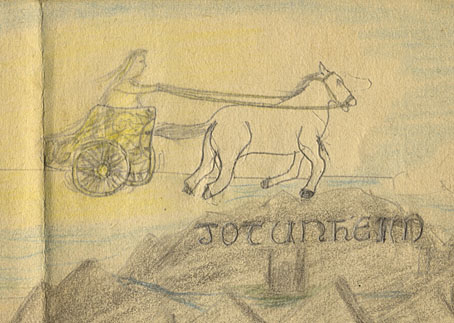
Sol in her Sun Chariot. The horse evidently looked better after a second attempt.
I can be specific about my age since I remember drawing this in 1973 shortly after moving to secondary school. The paper is the horrible stuff that was standard issue at that place, rough and terrible for pencil work. I’d been given a new set of coloured pencils so took advantage with this to use just about every colour in the box.
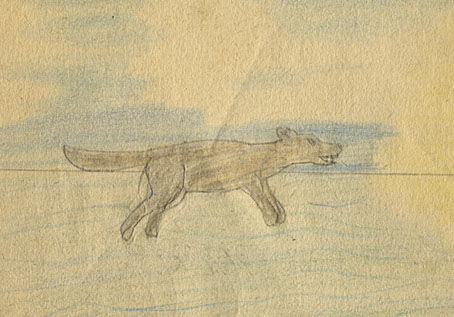
The wolf that chases Sol.
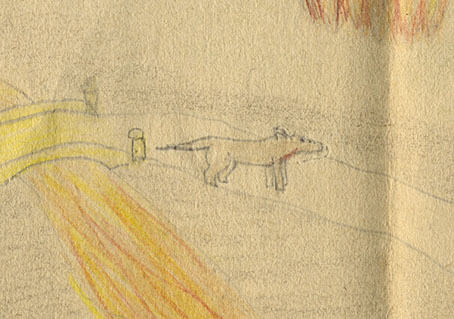
Beware the red-breasted mutt! The gates of Helheim.
For a while after drawing this I felt it was quite successful which is one reason I took the trouble to preserve it; looking at it now I’m amused at how crude it is compared to my fond memories. A few years later I became fanatic about drawing tiny details but there’s hardly any detail here at all. The scary wolf that chases the chariot of the sun across the sky, and the bloody-chested creature guarding the gates of Helheim look like oversize doggies.
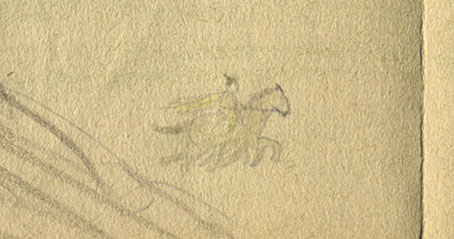
Odin on Sleipnir.
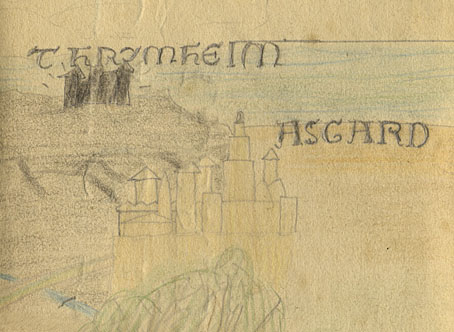
The letter shapes were carefully copied from an alphabet I found somewhere but I can’t remember the source. My being so well-versed in Norse mythology was down to my favourite book at the time, The Myths of the Norsemen by Roger Lancelyn Green. I also liked the illustrations in Green’s book by Brian Wildsmith whose drawing of Odin’s magical steed, Sleipnir (below), is echoed by my own minuscule version at the bottom of the map.
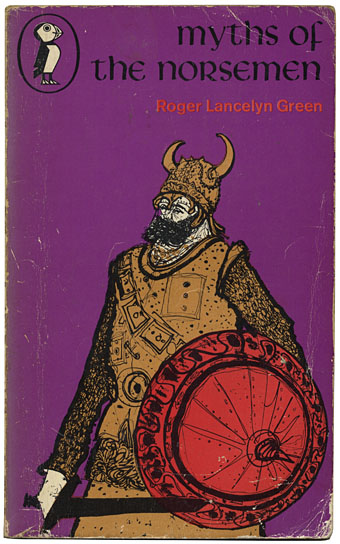
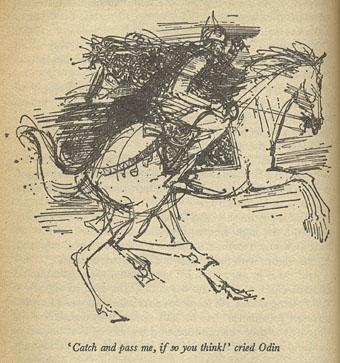
This fondness for the adventures of Odin, Thor, Loki, and company sent me to the Marvel Comics stories about Thor which I read for a while but didn’t enjoy half as much. Jack Kirby’s Thor presented Asgard as a kind of bad science fiction which lacked the darkness and strangeness of Green’s retellings. Beneath the surface of Green’s prose you sense the harsh and violent world which gave birth to myths of Gods and Giants, the world which also gave us Beowulf; Marvel’s equivalent seemed horribly plastic and artificial, like a Las Vegas imitation of something deep and filled with dread; the dread, of course, being Ragnarok which all the gods know is coming but are powerless to prevent. Green’s book relates the Twilight of the Gods in a thrilling and powerful final chapter.
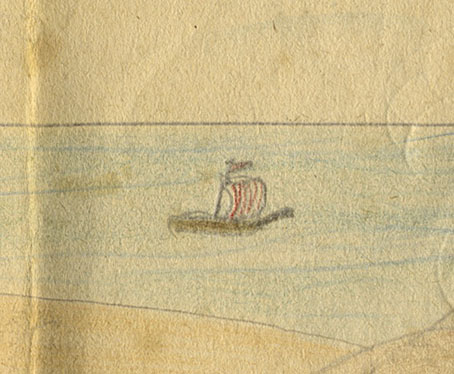
This tiny detail of a Viking longship presages the future in a way I couldn’t have anticipated. In 2007 I designed a CD package for Finnish metal band Turisas, an elaborate concept album which relates the journey of a longship along the Varangian trade route from the Gulf of Finland to Byzantium. If my 11-year-old self could have seen into the future I’m sure he would have been thrilled by the idea and by the pictures.
Previously on { feuilleton }
• Cain’s son: the incarnations of Grendel

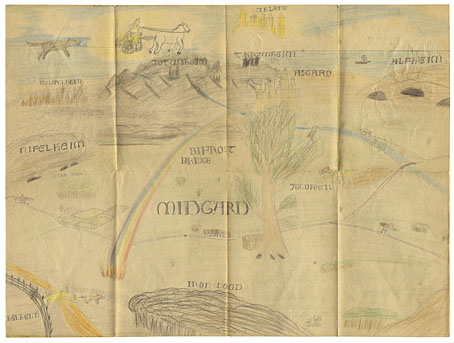
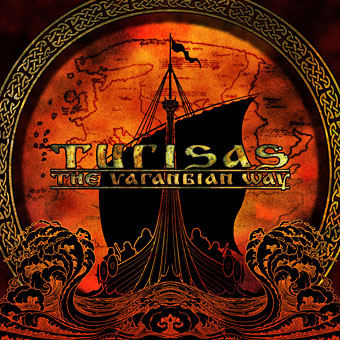
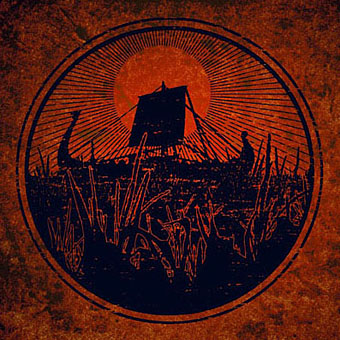
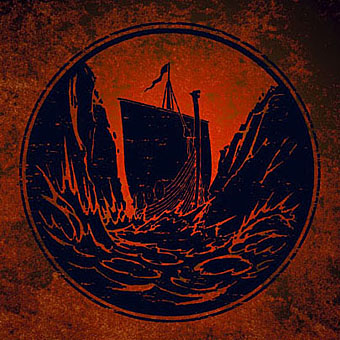
John, these are fabulous!
Thanks for sharing your eleven year old self!
John, I find this to be one of your most fascinating posts! Thanks for sharing this glimpse of your youth and the beginnings of a creative and artistic life. It’s interesting and also rather sweet.
Oddly enough, moments before reading this I was watching Salman Rushdie on television talking about Beowulf and the Twilight of the Gods!
(Also, the title of this post brings to mind an old song by R.E.M. on the last album of theirs that I actually enjoyed, from over 25 years ago.)
Thom: As it happens AS Byatt’s latest book is about Ragnarok, and I was wondering whether to buy it. That REM song was indeed the one I had in mind for the title, that album is also one of theirs I actually liked. Always found them rather dull.
John, the very idea of you listening to R.E.M. is just wrong. HA! I liked their first three albums, stopped caring immediately thereafter.
I had a similar reaction to Edith Hamilton’s mythology when I was about 11 too
http://en.wikipedia.org/wiki/Mythology_(book)
It was my fathers’ old tattered paperback copy with this image of Cellini’s Perseus on the cover but with more detail to it then the blank white background shown here :
http://philosophyofscienceportal.blogspot.com/2011/08/edith-hamiltonclassical-scholar.html
And then I discovered Monty Python and my life was never the same again. :-)
REM I like some songs but has anybody ever forgiven them after Shiny Happy People?
Ragna Rock
http://www.amazon.com/exec/obidos/tg/detail/-/B0000011L5
Michael Moorcock plays banjo?
Bipolar Monsters
http://www.youtube.com/watch?v=4QBCOC9HhMo&feature=fvst
:-)
Thom: A friend I was sharing a place with had the albums. He soon tired of them as well.
Gabriel: That album is also produced by Brian Eno. I preferred Calvert’s first album, Captain Lockheed & The Starfighters, it’s more coherent, has better songs and features most of Hawkwind (including Lemmy) when they were at their height. Lucky Leif is a collection of Viking-themed pastiches, not all of which are successful.
Magical drawings, glad you posted them and that some of them survived years later…
Fantastic post John. (I too have lost all but one of my childhood drawings.) What I love about this childhood survival of yours is that you made yourself a map, as though by doing so you could better envisage the place that had captured your imagination. As a child I loved the maps in the end-papers of books… Tolkien and Le Guin and many others… and returned to them again and again to trace the journeys of the characters I liked best. I wonder whether illustrators continue this tradition today. In a world of Sat-Nav perhaps maps don’t hold the same allure for the young.
I remember that paper! It was crap and you had to press twice as hard to make a drawing work, especially with those too-unyielding graphite pencils that sharpened to a great point but didn’t ever leave the kind of black mark I wanted!
Thank you , theses are really enchanting. I wish my eleven year old self had known your eleven year old self. Donn P. Crane and his illustrations for My Book House were my introduction to Teutonic mythology, that and Wagner.
I created a little volume of mythology of my own invention, an odd mish-mash of Greek, Egyptian, and Norse, I was about the same age. My mother managed to hold onto it, for which I am grateful.
Again thank you for sharing the images,
Leonard
Leonard, you should post images of the little volume your mother preserved. That would be lovely to see!
Thanks, everyone!
Clive: I definitely did want to imagine this strange collection of worlds as fully as possible. Reading and listening to music invoked powerful visions of things that I felt the urge to set down on paper. At this age the results were almost always disappointing but I thought well enough of this example to preserve it.
The first Earthsea book is one of my favourite fantasy books, I’ve read it many times (also written about it here if you search back). I used to be more interested in a book if it contained a map.
Leonard: I’d vote for seeing some of your early work as well. And it would have been fun to have a friend at that age who shared this obsession. My friends read fantasy and sf (some of them read Tolkien before I did) but I never knew anyone who’d read the Norse tales.
Dear John and Clive,
When I discovered John;s inventive drawings, I was inspired to recover my own childish fantasies, scrambling through my overheated crawl space was maddening and unproductive. They are somewhere, tucked ‘safely” away , will need to recover them.
Like Clive I was wild about the Tolkien endpapers, less wild about Tolkien’s actual tales, but I did eventually read and enjoy them.
My fascination with Norse mythology was more influenced by Wagner then Tolkien. My German grandmother was an antiques dealer, I remember bronze figures of Siegmund and Sieglinde, they opened the way for my fascination.
As always, thank you John, your site is what I read first almost every day, take care,
LG